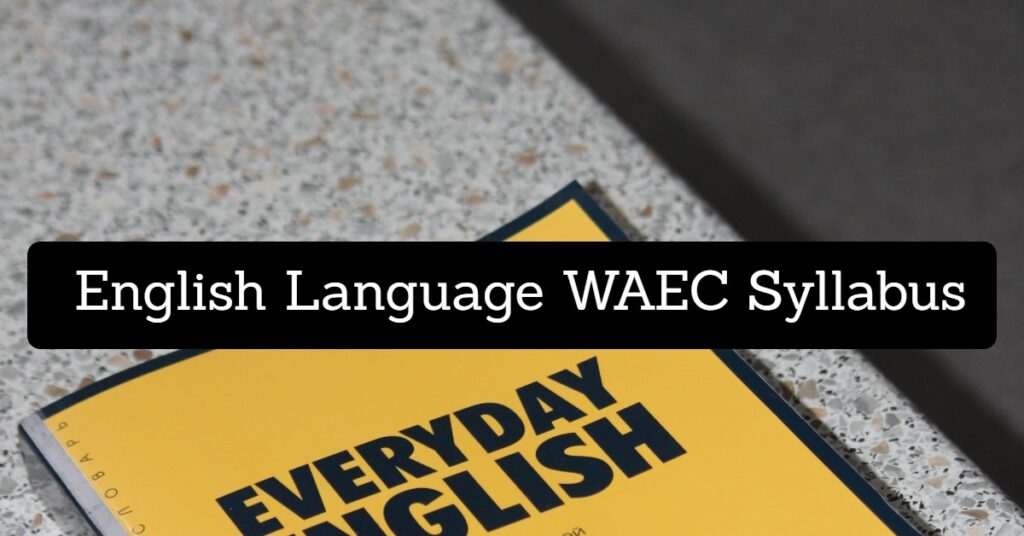
The WAEC English Language Syllabus is essential study material for anyone preparing to take the examination. It encompasses the aims and objectives, along with detailed notes and the format of the English Language exam.
Studying the English Language syllabus is crucial for effective exam preparation. It acts as a roadmap, guiding you on the topics to focus on. Additionally, it provides valuable notes on key concepts you need to understand.
Skipping the English Language syllabus during your exam preparations is akin to heading to a farm without your agricultural tools – you’ll likely find yourself less productive.
Make sure to kickstart your exam preparations by thoroughly studying the syllabus.
This post includes the English Language syllabus as well as the recommended textbooks from the West African Examination Council (WAEC).
Feel free to drop any questions in the comments section. I’m eager to assist you further.
WAEC English Language
This examination sets out to test the different basic skills of communicating in English using the mediums of speech and writing.
The examination will test the receptive and productive abilities of candidates.
These abilities will be demonstrated in the following forms: reading, comprehension, summary, vocabulary, lexis and structure, listening comprehension and recognition of different aspects of spoken English.
Aims and Objectives
The syllabus aims to measure the extent to which the aims of the teaching syllabuses of member countries have been realized in candidates’ secondary school careers.
The examination sets out to examine candidates’ ability to
- Use correct English;
- Write about incidents in English that are appropriate to specified audiences and situations;
- Organize material in paragraphs that are chronologically, spatially and logically coherent;
- Control sentence structures accurately;
- Exhibit variety in the use of sentence patterns;
- Comply with the rules of grammar;
- Spell and punctuate correctly;
- Comprehend written and spoken English;
- Recognize implied meaning, tones and attitudes;
- Use an acceptable pronunciation that others can comprehend;
- Recognize the physical characteristics of English sounds and the letters that represent them.
- Pick out and summarize relevant information from set passages.
Scheme of Examination
There will be three papers.
Papers 1, 2 and 3, all of which must be taken. Papers 1 and 2 will be composite papers to be taken at one sitting.
Paper 1
It will consist of eighty multiple-choice questions, all of which should be answered within 1 hour for 40 marks.
Paper 2
It will consist of five essay topics and a passage each to test candidates’ comprehension and summary skills.
Candidates will be expected to write an essay on one of the topics and answer all the questions on the comprehension and summary passages.
The paper will last 2 hours and carry 100 marks.
Paper 3
It will consist of sixty multiple-choice items on the Test of Orals for candidates in Nigeria and Liberia and the Listening Comprehension Test for candidates in the Gambia and Sierra Leone.
All the questions should be answered in 45 minutes for 30 marks.
WAEC English Language Syllabus
Paper 1
PAPER 1: (For candidates in The Gambia, Nigeria, Sierra Leone and Liberia only)
This objective/multiple choice paper comprises eighty questions: forty lexical and forty structural questions. Each question will have four options lettered from A to D.
Lexis
In addition to items testing knowledge of the vocabulary of everyday usage (i.e. home, social relationships, and common core school subjects), questions will be set to test candidates’ ability the use the general vocabulary associated with the following fields of human activity:
- Building and Building Construction;
- Agriculture
- Fishing
- Stock exchange
- Health
- Environment
- Culture, Institutions and Ceremonies
- Law and Order
- Motor Vehicles and Travelling
- Government and Administration
- Sports
- Religion
- Science and Technology
- Animal husbandry
- Advertising
- Human Internal Body System and Function
- Idioms, i.e. idiomatic expressions and collocations (e.g. ‘hook, line and sinker, ‘every Tom, Dick and Harry,” etc.), the total meaning of which cannot be arrived at simply by consideration of the dictionary meanings of the words in the structures in which they appear.
- Structural elements of English, e.g. sequence of tenses, matching of pronouns with their antecedents, correct use of prepositions etc.
- Figurative Usage
The term ‘general’ vocabulary refers to those words and usage of words normally associated with the fields of human activity in A1 above which are generally known, used and understood by most educated people who, while not engaged in that field of activity may have occasion to read, speak or write about it.
Thus, for example, in the vocabulary of transportation by road, one would expect knowledge of terms such as ‘pedestrian bridge’ and ‘traffic signs’, which most educated people understand, but not ‘berm’ or ‘camber’, which are specialized.
All items will be phrased in such a way as to test the use and understanding of the required lexis rather than dictionary definitions and explanations.
In practice, the test of lexis will be so designed to explore not merely the extent of the candidates’ vocabulary but, more importantly, their ability to respond to sense relations in the use of lexical items, e.g. synonyms, antonyms and homonyms.
In the test of figurative language, candidates will be expected to recognize when an expression is used figuratively and not only when it is used literally.
Structure
Structure here includes:
- The patterns of changes in word forms indicate number, tense, degree, etc;
- The patterns in which different categories of words regularly combine to form groups and these groups, in turn, combine to form sentences;
- Using structural words, e.g. conjunctions, determiners, prepositions, etc.
Paper 2
PAPER 2: (For all candidates)
The paper will be divided into three sections: Sections A, B and C. Candidates will be required to spend 2 hours on this paper.
Section A
SECTION A: ESSAY WRITING (50 marks)
Candidates will be required to spend 50 minutes on this section.
There will be five questions in all, and candidates will be required to answer only one question.
The questions will test candidates’ ability to communicate in writing. The topics will demand the following kinds of writing:
- letter;
- speech;
- narration;
- description;
- argument/debate;
- report;
- article;
- exposition;
- creative writing.
Marks will be awarded for:
- Content: relevance of ideas to the topic;
- Organization: formal features (where applicable), good paragraphing, appropriate emphasis and arrangement of ideas;
- Expression: effective control of vocabulary and sentence structure;
- Mechanical Accuracy: correct grammar, punctuation, spelling etc.
The minimum length will be 450 words.
Section B
SECTION B: COMPREHENSION (20 marks)
Candidates will be required to spend 30 minutes on this section. The section will consist of one passage of at least three hundred and fifty (350) words.
Candidates will be required to answer all the questions on the passage.
The questions will test candidates’ ability to
- find appropriate equivalents for selected words or phrases;
- understand the factual content;
- make inferences from the content of the passage;
- understand the use of English expressions that reveal/reflect sentiments/emotions/attitudes;
- identify and label basic grammatical structures, words, phrases or clauses and explain their functions as they appear in the context;
- identify and explain basic literary terms and expressions;
- recast phrases or sentences into grammatical alternatives.
The passage will be chosen from a wide variety of sources, all of which should be suitable for this level of examination in terms of theme and interest.
The passage will be written in modern English, which should be within the experience of candidates.
The comprehension test will include at least four questions based on (ii) above.
Section C
SECTION C: SUMMARY (30 marks)
Candidates will be required to spend 40 minutes on this section.
The section will consist of one prose passage of about five hundred (500) words and will test candidates’ ability to
- extract relevant information;
- summarize the points demanded in clear, concise English, avoiding repetition and redundancy;
- present a summary of specific aspects or portions of the passage.
The passage will be selected from a wide variety of suitable sources, including excerpts from narratives, dialogues and expositions of social, cultural, economic and political issues in any part of the world.
Part 3
PAPER 3: ORAL ENGLISH (30 marks)
This paper will test candidates’ knowledge of Oral English. There will be two alternatives for this paper: Candidates in Ghana, The Gambia and Sierra Leone will be tested in listening comprehension, and those in Nigeria and Liberia will take a paper on a test of oral.
Listening Comprehension Test: (For candidates in Ghana, The Gambia and Sierra Leone)
This will be made up of sixty multiple choice objective questions on:
Consonants, consonant clusters, vowels, diphthongs, stress and intonation patterns, dialogues and narratives.
- Section 1: Test of word-final voiced-voiceless consonants in isolated words mainly, but other features such as consonant clusters may also be tested.
- Section 2: Test of vowel quality in isolated words.
- Section 3: Test of vowel quality and consonant contrasts in isolated words.
- Section 4: One of the three options below will be used in different years:
- test of vowel and/or consonant contrasts in sentence contexts;
- test of vowel and consonant contrasts in isolated words- to be selected from a list of at least four-word contrasts;
- test of vowel and consonant contrasts through rhymes.
- Section 5: Test of rhymes
- Section 6: Test of comprehension of emphatic stress
- Section 7: Test of understanding of the content of longer dialogues and narratives
NOTE: CD players will be used for the administration of this Listening Comprehension Test.
Features to be tested
- CONSONANTS
- Single Consonants – Candidates should be able to recognize and produce all significant sound contrasts in the consonantal system of English. For the guidance of candidates, a few examples of such contrasts are given below.
Initial Medial Final
they – day buzzes – buses boat – both
ship – chip parcel – partial breathe – breed
fan – van sopping – sobbing wash – watch
pit – fit written – ridden leaf – leave
pit – bit anger – anchor cup – cub
tuck – duck faces – phrases cart – card
card – guard prices – prizes
gear – jeer
- Consonant Clusters – Candidates should be able to produce and recognize consonant clusters which may occur both initially and finally in a syllable. They should also be able to recognize and produce consonant sounds in a consonant cluster in the right order. For the guidance of candidates, a few examples are given below.
Initial Final
play – pray rains – range
sting – string felt – felled
scheme – scream sent – send
crime – climb nest – next
flee – free ask – axe
three – tree lift – lived
true – drew missed – mixed
blight – bright seats – seeds
tread – thread hens – hence
drift – thrift lisp – lips
glade – grade coast – coats
marks – masks
Vowels
- Pure Vowels
- Diphthongs
- Triphthongs
Candidates should be able to recognize and produce all the significant sound contrasts in the vowel system of English. For the guidance of candidates, a few examples of such contrasts are given below.
- seat – sit
- sit – set
- peck – pack
- pack – park
- cart – cat
- load – lord
- pair – purr
- park – port
- hard – heard
- word – ward
- let – late
- cheer – chair
- pet – pat – part – pate
- hat – heart – height – hate – hut
- caught – cot – cut – curt
- pool – pull – pole
- bird – bed – bared
- but – bat
Stress
Word Stress
Word Stress – Candidates should be able to contrast stressed and unstressed syllables in words which are not otherwise distinguished.
In addition, they should be aware of the possibility of shifting stress from one syllable to another in different derivations of the same word with the consequent change in vowel quality.
For the guidance of candidates, a few examples of changing word stress are given below.
- ‘increase (noun) in’crease (verb)
- ‘import “ im’port “
- ‘rebel “ re’bel “
- ‘convict “ con’vict “
- ‘extract “ ex’tract “
- ‘record “ re’cord “
- ‘subject “ sub’ject “
Sentence Stress
Sentence Stress – Candidates should be aware that stress in sentences in English tends to occur at regular intervals in time. English is therefore called a stress-timed language.
They should also be aware that in most sentences unless some sort of emphasis is introduced, only nouns, main verbs (not auxiliaries), adjectives and adverbs are stressed.
Final pronouns should not be stressed unless some kind of contrast is intended: relative pronouns should not be stressed, nor should possessive pronouns.
Thus, for example, the following sentences should be stressed as indicated:
- He ‘went to the town and ‘bought some ‘oranges.
- I ‘told him to ‘go to the ‘station to ‘ask when the train would ‘leave.
- Did you ‘ask him?
- I ‘read it but I did not understand it.
- They ar’rived yesterday.
- I ‘fetched his ‘book.
NOTE: A few English words are pronounced differently depending on whether or not they are stressed in the sentence. These are usually called strong and weak forms.
Emphatic Stress
Emphatic stress – Candidates should be aware of the use of emphatic stress, most commonly to indicate a contrast, which is realized partly as a change in pitch within the intonational pattern.
This falling pitch illustrated below is one of the common ways of indicating this:
- He borrowed ‘my newspaper. (i.e. not hers)
- He’ borrowed my newspaper. (i.e. he did not steal it)
- He borrowed my ‘newspaper.(i.e. not my book)
- ‘He borrowed my newspaper.(i.e. not someone else’s)
Intonation
Candidates should be made aware of the different forms that English intonation takes in relation to the grammar of the language and the attitudes conveyed by the speaker.
There are two basic intonation patterns or tunes: the falling and rising patterns.
They should also realize that whereas the normal place for the changing pitch in an intonation is the last stressed syllable of the utterance (as indicated below), placing the changing pitch elsewhere implies a contrast to the item on which this changing pitch falls. For example:
Falling Pattern
- They ar’rived to’day. – Statement
- ‘Where did he ‘go? – WH question
- ‘Come ‘here! – Command
Rising Pattern
- Did he ‘see the ‘principal? – Yes/No question
- When the ‘train arrived. – Incomplete
- They arrived to’day? – Question
Note that (i) the two patterns indicated above may be combined in longer sentences, e.g.
When the ‘train ar’rived, the passengers were on the platform. ( )
(ii) candidates should note, in addition, that any unstressed syllable following the last stressed syllable of the sentence is said on a low level pitch when the pattern is falling, but continues the rise if the pattern is rising. The same rule applies to tags following quoted speech.
Oral English
Test Of Orals (For candidates in Nigeria and Liberia)
The test will also be of the multiple-choice objective type consisting of sixty questions on a wide range of areas or aspects of Orals as contained in the syllabus.
The test will cover the following areas:
- Vowels – pure vowels and diphthongs;
- Consonants and clusters;
- Rhymes;
- Word stress/Syllable Structure;
- Emphatic Stress/Intonation Patterns;
- Phonetic Symbols.
WAEC English Language Textbooks
Here is the list of WAEC recommended textbooks for the English Language;
- Attah, M. O. (2013). Practice in Spoken English for Intermediate and Advanced Learners, Maiduguri: University of Maiduguri Press.
- Bamgbose, A. (2002). English Lexis and Structure for Senior Secondary Schools and colleges (Revised Edition), Ibadan: Heinemann
- Banjo, A. et al (2004). New Oxford Secondary English Course Book Six for Senior Secondary Schools, Ibadan: UP Plc.
- Caesar, O. J. (2003). Essential Oral English for Schools and Colleges, Lagos: Tonad Publishers Limited
- Daniel Jones (2011). Cambridge English Pronouncing Dictionary, Cambridge: Cambridge University Press
- Egbe, D. I (1996). Mastering English Usage and Communication Skills, Lagos: Tisons
- Elugbe, B. (2000). Oral English for Schools and Colleges, Ibadan: Heinemann
- Grant, N. J. H, Nnamonu, S. Jowitt, D. (1998). Senior English Project 3, (New Edition) Harlow: Longman
- Idowu, O. O, Sogbesan, T. S, Adofo, A. K. Burgess, D. F and Burgess, L. J. (1998). Round-up English: A Complete Guide, Lagos: Longman
- Idris, U. (2001). Oral English at Your Fingertips for Schools and Colleges, Lagos, M. Youngbrain Publishers
- Igiligi, E. C. and Ogenyi, S. O. (2010) Grammar and Composition in the G.S.M. Age, Enugu: Joe Hills Production Services
- Jauro, L. B. (2013). Oral English for Schools and Colleges: A teaching and Learning Approach, Yola: Paraclete Publishers.
- Nnamonu, S. and Jowitt, D. (1989). Common Errors in English, Lagos: Longman
- Obinna, M. F. (2001). University Matriculation Use of English,(Fourth Edition) Port Harcourt: Sunray Books Limited
- Ogunsanwo, O. Duruaku, A. B.C, Ezechukwu, J and Nwachukwu, U. I (2005). Countdown English Language, (Revised Edition), Ibadan: Evans
- Olatoye, S. (2006). The Silent Teacher, Ado-Ekiti: Segun and Sons Enterprises
- Oluikpe, B. O. A, Nnaemeka, B. A, Obah, T. Y, Otagburuagu, E. J. Onuigbo, S. and Ogbonna, E. A. (1998). Intensive English for Senior Secondary School 3, Onitsha: Africana – FIRST Publisher.
- Tomori, S. H. O (2000). Objective Tests for School Certificate English: Practice in Lexis, Structure and Idiom (Reprinted Edition), Ibadan: Heinemann
- Ukwuegbu, C, Okoro, O., Idris, A. U., Okebukola, F. O. and Owokade, C. O. (2002). Catch-up English for SSCE/UME, Ibadan: Heinemann
Let me know if you have any questions or need further clarification. I would love to assist you.

